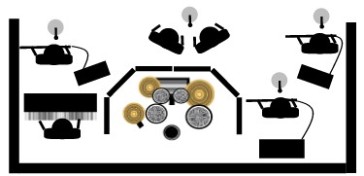As mentioned earlier in my research, I have taken a deeper look into how drum shields work and whether they can help create a much better vocal clarity when used. It was difficult to find the information as a lot of the pieces were from drummers saying how much they hate being put behind them! Here is the information I gathered;
– Using a 5 ft tall panel of plexiglass (the shield) is enough to block the majority of the cymbal sounds going into the vocal microphone (as well as other microphones not used on the drum kit).
– If the drums are situated on a drum riser so that the cymbals are above the vocal microphone, then a 4 ft tall shield will be adequate.
– The amount of panels used depend on the size of the band. Below are some examples of this taken from the website;
Above: A four panel setup suitable for when band members are situated in front of the drum kit.
Above: A five panel setup for when band members are closer to the sides of the drum kit.
Above: A six panel setup for when the band members are directly to the sides of the drum kit.
“As the drums move towards the front of the stage, you need to increase the number of panels to provide more side converge”, (Drum Perfect, Unknown).
I also gathered further information about the materials used in drum shields.
– The shields are made from 1/4″ thick clear acrylic sheets.
– Approximate weights are 12 pounds for each individual 4 ft panel and 16 pounds for each individual 5 ft panel.
Honestly, I don’t think that drum shields look too bad on a stage. However I do believe that the drummer needs to be happy if having to use a shield as if he isn’t, then he may put on a bad performance which is then going to affect the entire band sound. Even if the vocals are mixed to perfection, if the rest of the band aren’t performing as well as they could, how important is the vocal clarity going to be? Happy band = better performance.
Interestingly from a book I recently purchased, (Live Audio: The Art of Mixing A Show), there was a quick mention about drum shields;
“The only problem with putting up big screens is that they can really detract from the rest of the set, which doesn’t always go over well with the management, record company, and/or artist. (They also require a lot of cleaning – there’s nothing worse than looking at greasy fingerprints all over a screen). Instead of getting full screens made, it is possible to get smaller screens made that just cover the cymbals at the front of the kit. At least this way you are still reducing the level of the high end that will be going down the vocal mic”. (Swallow, 2011).
So it seems that drum shields are hit and miss. Although I don’t think they look bad on stage (as long as they are clear and you can still see the drummer), how many others want to have to look at one for a two hour show? I go back to saying that I think it depends on the music genre. When going to see a band known for an amazing live sound who don’t necessarily put on a big stage performance, I think a drum shield would be suited. Whereas if the band were known big performances and stage presence, I think a drum shield would be less suitable as the audience would be more interested in seeing the band and their performance rather than looking through some plexiglass at a caged animal!
But I’ll leave it there before I start moving completely away from working on vocal clarity. It would be interesting to carry on researching how much effect a shield can have, but I’ll have to do that in my own time. Unfortunately I don’t have access to a plexiglass drum shield to experiment with, but if I ever get the chance, count me in!
The full article on drum shields can be found at http://www.drumperfect.com/htdocs/drum_shield_faq’s.htm




